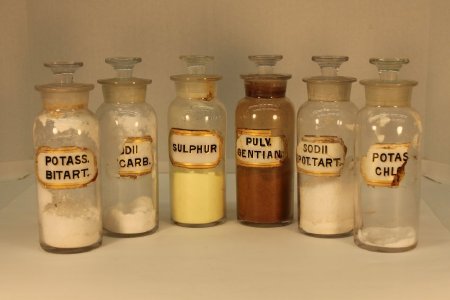Object ID Number:
PH101
Object Name:
Bottles
Type:
Shop Furniture
Manufactured from:
1820
Manufactured to:
1850
Description / History:
In this collection there are six cylindrical bottles used to carry different powdered chemicals that could have been combined to create medicines. The bottles are fairly big and therefore were used to store a large amount of supply over a long period if time. The bottles are made of hand–blown glass with smooth bottoms and therefore would have been used in the mid 19th century. The bottles contain glass labels that are outlined in a gold and red paint with the name of the chemical painted in black and gold. Below is a short description about the original contents that remain in the bottle today.
Bottle A: Bottle A has a glass label reading "Sulphur." Inside the bottle is a finely ground powder that is yellow in color (about halfway full). Sulphur would have been combined with many other chemicals to create chemical compounds necessary in the pharmaceutical industry. In the 1800s, children were often given a spoonful of sulphur and molasses as a spring tonic. Today, many drugs containing sulfur fight the bacteria responsible for meningitis.
Bottle B: Bottle B contains an unreadable label due to a broken label it appears to have the word Sodii in the label. The bottle is about 1/8 full with a white powder. Some of the white powder has clumped together to create large blocks. It looks very similar to the texture and color of baking soda.
Bottle C: Bottle C has a broken label, but enough letters remain that we are able to determine the contents as potassium chloride. There a small amount of finely ground white crystal remaining. Today, potassium chloride is used as an electrolyte replenisher, however it has been known to induce side effects of diarrhea, vomiting, and bleeding of the intestinal track. Back in the 1800s, potassium chloride would have been used to produce these side effects which were believed to get the disease out of the body.
Bottle D: The label on bottle D reads "Potass. Bitart," also known as potassium bitartrate. There is about a quarter of white powder still remaining in the bottle. Potassium bitartrate would have been used in the 1800s to rid a patient of bacteria and disease by flushing out their intestinal track. Today it is used to relieve constipation and to empty the colon before surgical operations.
Bottle E: The label on bottle E reads " Sodii e.Pot. Tart," also known as sodium potassium tartrate. The bottle is approximately halfway full of a white powder. Sodium Potassium Titrate was found by an apothecary, Pierre Seignette in La Rochelle, France, and therefore is often called Seignette's salt or Rochelle salt. This was and is still used today as a laxative.
Bottle F: Bottle F contains the label "Pulv. Gentian," which is a ground product of the herb, gentian. Gentian's original uses were to stimulate appetite, improve digestion, and treat a variety of GI complaints. The ground herb is brown in color and the bottle is approximately half full.
Bottle A: Bottle A has a glass label reading "Sulphur." Inside the bottle is a finely ground powder that is yellow in color (about halfway full). Sulphur would have been combined with many other chemicals to create chemical compounds necessary in the pharmaceutical industry. In the 1800s, children were often given a spoonful of sulphur and molasses as a spring tonic. Today, many drugs containing sulfur fight the bacteria responsible for meningitis.
Bottle B: Bottle B contains an unreadable label due to a broken label it appears to have the word Sodii in the label. The bottle is about 1/8 full with a white powder. Some of the white powder has clumped together to create large blocks. It looks very similar to the texture and color of baking soda.
Bottle C: Bottle C has a broken label, but enough letters remain that we are able to determine the contents as potassium chloride. There a small amount of finely ground white crystal remaining. Today, potassium chloride is used as an electrolyte replenisher, however it has been known to induce side effects of diarrhea, vomiting, and bleeding of the intestinal track. Back in the 1800s, potassium chloride would have been used to produce these side effects which were believed to get the disease out of the body.
Bottle D: The label on bottle D reads "Potass. Bitart," also known as potassium bitartrate. There is about a quarter of white powder still remaining in the bottle. Potassium bitartrate would have been used in the 1800s to rid a patient of bacteria and disease by flushing out their intestinal track. Today it is used to relieve constipation and to empty the colon before surgical operations.
Bottle E: The label on bottle E reads " Sodii e.Pot. Tart," also known as sodium potassium tartrate. The bottle is approximately halfway full of a white powder. Sodium Potassium Titrate was found by an apothecary, Pierre Seignette in La Rochelle, France, and therefore is often called Seignette's salt or Rochelle salt. This was and is still used today as a laxative.
Bottle F: Bottle F contains the label "Pulv. Gentian," which is a ground product of the herb, gentian. Gentian's original uses were to stimulate appetite, improve digestion, and treat a variety of GI complaints. The ground herb is brown in color and the bottle is approximately half full.
Dimensions:
H–8.5 Dia–2.75 inches
3D Image Information:
The 3 dimensional image can be viewed using Google Chrome, Safari, or Firefox browsers.
3 Dimentional Image:
